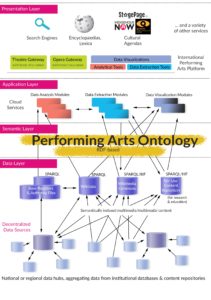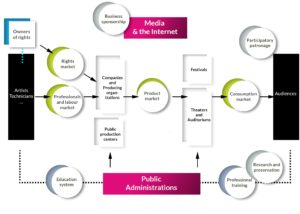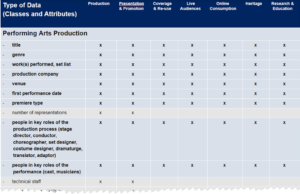Building a Linked Open Data Ecosystem for the Performing Arts
Over the past six months, the BFH Institute for Public Sector Transformation has had the pleasure to accompany the Canadian Arts Presenting Association’s Linked Digital Future Initiative, which intends to leverage the potential of linked open data in the area of the performing arts. At the difference of earlier projects we have been involved in, this initiative focuses on the primary value chain of the performing arts, made up of artists, production companies, presenting organizations, ticketing platforms, and operators of arts facilities. We have used this as an occasion to get an overview of the entire performing arts value network and to reach a better understanding of the various stakeholder perspectives on what may be called the International Knowledge Base for the Performing Arts.
Linked data is not only about putting a new technology to use, but even more so about creating a shared vision and developing a collaborative spirit among partners that hitherto have hardly been aware of each other. By some interesting twist of fate we have found ourselves in the role of seeking to achieve exactly this with regard to the various stakeholders of the performing arts sector – a sector, which in some parts has a rather local or regional focus, but in other parts is clearly international in scope.
Our journey into the realm of performing arts data had started back in 2013 in collaboration with the Swiss Theatre Collection who needed to renew their data platform. A few years later, we had the chance to interact with partners at the international level who pursued the vision of creating an international knowledge base for the performing arts. While our first interlocutors had a heritage background and an exclusive focus on theatre and dance, we gradually got involved with people from other segments of the performing arts value network, such as educational and research institutions, volunteers contributing to the free online encyclopaedia Wikipedia, or researchers analyzing opera performances. Yet, it was only in the course of a mandate from the Canadian Arts Presenting Association that we got more directly involved with agents of the primary value chain of the performing arts sector. This completed the picture, and the moment had come to provide an overview of the various stakeholders and their usage scenarios with regard to a shared database, in order to stake out the common ground and to flag areas where important synergies between stakeholders are to be expected.
The Vision: A Distributed Database Catering to the Needs of a Variety of Stakeholders
Over the past years there have been various efforts and initiatives to create an International Knowledge Base for the Performing Arts based on linked data technology, relying both on Wikidata and the classical linked data approach. The idea is to build a platform consisting of several layers (see figure 1):
- a data layer, consisting of decentralized data sources and several data hubs aggregating and interlinking data relating to the performing arts;
- a semantic layer, consisting of a shared data model, a so-called “ontology”;
- an application layer, consisting of various cloud services for data extraction, data analysis, and data visualization; and
- a presentation layer – the actual platforms and software applications end users interact with.

Figure 1: Architecture of the linked open data ecosystem for the performing arts
Performing Arts Value Network
In order to get a better understanding of the key stakeholders of such a distributed database, we started out from an overview of the performing arts value network and systematically described the usage scenarios from the perspective of the various stakeholders in view of a linked open data ecosystem for the performing arts.
As can be seen in figure 2, this value network comprises not only the primary value chain of the performing arts, made up of creators and artists, production companies, presenting organizations, ticketing platforms, and operators of arts facilities, but includes further stakeholders playing a role in the wider ecosystem of the performing arts, such as the media, educational institutions, institutions of professional training, researchers, or heritage institutions with collections relating to the performing arts.

Figure 2: Value network
Converging Needs in Terms of Data
To assess their needs in terms of data, the various stakeholders were assembled into seven categories, for which we established, on the basis of the usage scenarios that previously had been identified, what kind of data these different groups would require for their activities. In an overview table the data that is common to all of them was highlighted (figure 3). As it turns out, there is quite a large core of data relevant to various types of stakeholders. This indicates that it would be worthwhile for them to cooperate more closely in order to leverage the many synergies in the area of data management.

Figure 3: Extract of the overview table of required data
Pilot Applications of the Canadian Linked Digital Future Initiative
The primary implementation partners for the initial phase of the Canadian Linked Digital Future Initiative are the performing arts presenting network RIDEAU[1] and the start-up company Culture Creates[2]:
- RIDEAU’s ScènePro is a centralized information system for the performing arts production market. It integrates and facilitates various operations, such as showcase application, event registration, and block-booking. The goals of ScènePro are to reduce manual data population into different systems and to enable the re-use of core data across a number of business processes. ScènePro will thus gather a lot of reliable, validated, up-to-date information about performing arts companies, productions and presenters. Such information will then populate directories and applications intended for sector stakeholders. In addition, all non-sensitive information will be fed into the Canadian knowledge graph for the performing arts.
- Culture Creates has been developing tools and services to enhance the findability and discoverability of performing arts events in the consumption market. Its Footlight tool uses natural language processing and harvests unstructured or semi-structured event information on websites and translates it into machine-readable structured metadata. Upon validation of the metadata by the presenters of these events, the metadata is republished as JSON-LD embedded in the organizations’ websites and also being fed into the Canadian knowledge graph for the performing arts.
- Artsdata.ca is a Canadian performing arts knowledge graph initiated in 2018 by Culture Creates with the support of the Canada Council for the Arts and several arts organizations. Today, the graph database is still in its infancy. It is eventually meant to assemble all relevant data about current and future performing arts events in Canada and by Canadian artists or artists’ collectives abroad. Artsdata.ca is expected to become the Canadian hub within the international open data ecosystem for the performing arts.
Recommendations for the Next Phase
While various elements of the linked open data ecosystem for the performing arts have already been put in place, which is the case with large parts of the shared ontology as well as with the pilot implementations of Culture Creates’ Footlight tool and the Artsdata.ca knowledge graph, many challenges still lie ahead. To tackle them, the Advisory Committee has made five recommendations in view of the further implementation of the Linked Digital Future Initiative:
- Immediate focus should be placed on populating a Canadian performing arts knowledge graph. To do so, data about current and future events should be ingested into a knowledge graph or made available through interoperable data systems.
- Wikidata is complementary to Artsdata.ca; efforts should therefore be undertaken to contribute to its population with performing arts related data that is of relevance in the context of the Canadian knowledge graph.
- A data governance framework needs to be developed in cooperation with representatives from across the arts sector in order to establish who is able to share what type of data with whom, and who will have authority over which data/information.
- Further research is needed to better understand user requirements with regard to the adoption of linked open data practices in service offerings. Stakeholders who are expected to make an additional effort to contribute or enhance performing arts related data should know why they are doing so and for whom.
- Further effort is required to develop and describe novel business models that leverage and maintain a well-functioning linked open data ecosystem. It is essential to evaluate the long-term economic sustainability for individual contributions to the common knowledge graph by key players in the performing arts value network.
For further information
- Landing page of the Linked Digital Future Initiative’s Action Research
- Full Report – Estermann & Julien (2019): A Linked Digital Future for the Performing Arts (and as French version)
- Gregory Saumier-Finch (2019): How art institutions can manage their metadata
References
 Create PDF
Create PDF


 Beiträge als RSS
Beiträge als RSS
Dein Kommentar
An Diskussion beteiligen?Hinterlasse uns Deinen Kommentar!